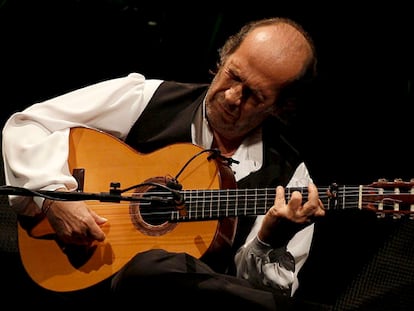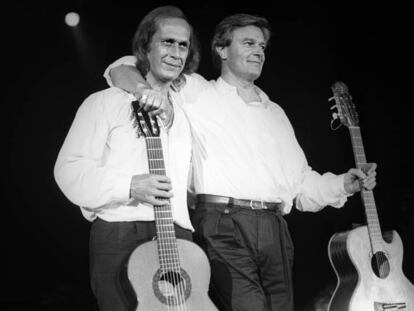Google doodle pays homage to Spain’s flamenco genius Paco de Lucía
Daily image features the guitarist, who died in 2014, and links to a digital exhibition about his work
It’s not often a Spaniard is honored with a Google doodle, but this Wednesday the search engine is celebrating what would have been the 69th birthday of Francisco Sánchez Gomes, better known to lovers of flamenco guitar as Paco de Lucía, arguably the greatest exponent of one of Spain’s greatest contributions to the arts.
At the same time, the Google Cultural Institute is hosting a digital exhibition in memory of the guitarist on its Arts & Culture portal.
The exhibition charts the life and times of a man who revolutionized flamenco guitar, opening the form to a new audience, and features photographs and videos from his early years.
His flirtation with jazz earned him accusations of bastardizing flamenco
De Lucía, who died in 2014, was a universally acclaimed artist who won the 2004 Prince of Asturias Award for his tireless exploration of the possibilities of flamenco. He will also be remembered for his association with the late flamenco singer Camarón de la Isla.
Born Francisco Sánchez Gómez in 1947, De Lucía, shunned his own legend. Fame came early, in 1975, with his by-now famous rumba Entre dos aguas. It was the last track on the album of the same name that made its way into hundreds of thousands of Spanish homes as society was beginning to shake off the dark dust of the Franco dictatorship.
His association with Camarón alone – the pair released over 10 albums of traditional flamenco together as well as a flamenco-pop-rock fusion record – would have been enough to make De Lucía famous. But there was a lot more to come. His flirtation with jazz earned him accusations of bastardizing flamenco, but he kept on pushing the limits of his music and by the mid-1970s he had formed a sextet that included his two brothers, Pepe de Lucía and Ramón de Algeciras, as well as Jorge Pardo, Carles Benavent and Rubem Dantas. This musical group introduced the Peruvian cajón, a percussion instrument comprising a tall wooden box, into flamenco. Since then, it has become a staple of the genre.
Recorre "Memoria de Paco", la exposición de @googlearts que te acerca la vida y obra de Paco de Lucía → https://t.co/pPCXP8PJq7 pic.twitter.com/qLFUvMnzeM
— Google España (@GoogleES) December 21, 2016
De Lucía also incorporated blues, Indian music, salsa, bossa nova and Arabic music into his own sound. His performances at the Teatro Real opera house in Madrid helped blur the border between high-brow and popular music.
English version by Nick Lyne.
Tu suscripción se está usando en otro dispositivo
¿Quieres añadir otro usuario a tu suscripción?
Si continúas leyendo en este dispositivo, no se podrá leer en el otro.
FlechaTu suscripción se está usando en otro dispositivo y solo puedes acceder a EL PAÍS desde un dispositivo a la vez.
Si quieres compartir tu cuenta, cambia tu suscripción a la modalidad Premium, así podrás añadir otro usuario. Cada uno accederá con su propia cuenta de email, lo que os permitirá personalizar vuestra experiencia en EL PAÍS.
¿Tienes una suscripción de empresa? Accede aquí para contratar más cuentas.
En el caso de no saber quién está usando tu cuenta, te recomendamos cambiar tu contraseña aquí.
Si decides continuar compartiendo tu cuenta, este mensaje se mostrará en tu dispositivo y en el de la otra persona que está usando tu cuenta de forma indefinida, afectando a tu experiencia de lectura. Puedes consultar aquí los términos y condiciones de la suscripción digital.











































